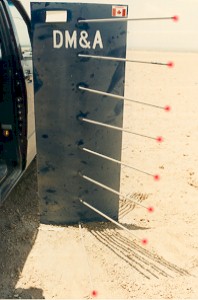

Left:Two metal cantilevers after the passage of the blast wave from a 2500-ton ANFO explosion. The rods were initially vertical. The blast wave traveled from right to left. Bend angles measure peak dynamic pressure and dynamic pressure impulse, depending on the length, cross-section and material used. Right: Eight metal cantilevers after the passage of the same wave, this time travelling from left to right. This array of horizontal cantilevers was used to measure the differences in dynamic pressure impulse with height above ground in the flow boundary layer. The bend angle is effectively zero for the bottom cantilever and it increases with height. The red dots were added to illustrate the boundary layer profile.